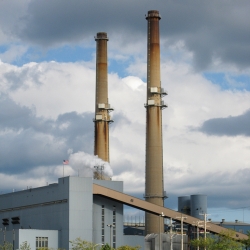State PSC Gives Huge Giveaway to Businesses
Electric ratepayers in one-half of the state will subsidize downtown Milwaukee businesses.

Menomonee Valley Plant Feature
In March, the state Public Service Commission made a remarkable ruling that will have tremendous benefits for downtown Milwaukee businesses. The commission approved a plan by We Energies that essentially requires all of its electric rate payers — more than one-half of the state’s population — to subsidize the steam power it provides to downtown customers, mostly businesses.
On April 16, the Citizens Utility Board filed suit, charging the plan “would force We Energies’ electric ratepayers to pay more than $250 million to subsidize big business steam customers in downtown Milwaukee.” The Commission’s decision, the suit says, blatantly violates Wisconsin law prohibiting rates that are “unjust, unreasonable, insufficient or unjustly discriminatory.”
The PSC oversees public utilities in the state, and has three board members appointed by the governor. In this decision, the two board members appointed by Republican Gov. Scott Walker, Phil Montgomery (board chair) and Ellen Nowak, ruled in favor of the We Energies plan, while Eric Callisto, a holdover on the board appointed by Democrat Jim Doyle, opposed it.
There’s been almost no media coverage of this story, though it has huge ramifications. The decision was favored by the Metropolitan Milwaukee Association of Commerce and other business lobbyists, and is certainly favorable to Milwaukee. But what about the many homeowners and renters who will help provide this subsidy? Their only lobbyist is the tiny, Madison-based Citizens Utility Board, which is likely to be badly out-lawyered when this case goes to court.
The plan revolves around the Menomonee Valley plant, the oldest facility run by We Energies. For year it has used been powered by coal, with very negative environmental consequences. The company plans to convert to natural gas, and the capital costs of converting to a gas-fired plant are an estimated $80 million.
The valley plant originally was oriented more toward providing electricity but as the company has added newer, more efficient plants, the valley facility’s primary purpose has been to provide steam for heating, hot water and air humidification for 450 downtown customers. The majority are businesses, but there are also government buildings, colleges (notably, Marquette University), churches, apartments, condominiums and entertainment venues that are served, says We Energies spokesperson Brian Manthey.
The plant generates 500 million kilowatt hours of electricity and 2.1 billion pounds of steam annually, according to We Energies. But CUB has estimated that, with the new plants added over the years, the valley plant was needed at most to provide 21 hours total in 2013 for electricity generation or system reliability, and at most 142 hours in 2023.
The We Energies plan approved by the PSC offers no breakdown of how much of the power provided goes to electric rate payers today, but instead offers a ratio established back in the 1960s, when the customer base was very different. The plan calls for steam customers to pay only $6.4 million or 8 percent of project’s capital costs, while electric customers will pay $74 million — 92 percent of total costs.
Even worse, over the life of the plant electric ratepayers would pay 100 percent of the estimated $185 million in “uneconomic dispatch costs,” added costs incurred solely to provide steam heating. (In essence, the plant will generate electricity at a cost considerably beyond market rates, and charge rate payers for this.)
We Energies notes that electric rate payers will benefit from operational savings once the plant is upgraded. But so will steam customers, though Manthey contends the benefit will be smaller for them.
As Urban Milwaukee has previously reported, John Feit, a staff member and economist with the PSC, declared that if not for steam customers, the valley plant would be retired. Feit also said the cost structure in the We Energies plan was based on “no analysis” by the company.
Yet the PSC’s two-person majority approved this. ”The commission makes no pretense that its adopted cost allocation is derived from any analysis of cost causation or the relative value of the plant among customer classes,” Callisto’s opinion charged. “Nowhere… is there an attempt to compare the value of Valley [plant] among electric and steam customers and assign costs accordingly.”
Richard Hahn a principal consultant with La Capra Associates Inc., an energy consulting firm retained by CUB, testified at the PSC hearings, saying “a strong case can be made that none of the cost of gas conversion should be allocated to electric customers.” If the PSC does allocate some of the cost to electric customers, it should at most be in the range of 11 percent to 22 percent, he added.
CUB has argued that electric customers should pay no more than 22 percent of capital costs and 0 percent of the uneconomic dispatch costs because the latter is all due to the need to supply steam customers.
“It is unfair to require electric ratepayers to cover 92 percent of the capitol costs for converting a utility plant that is inarguably a steam plant first, with electric output secondary,” Callisto contended. “It is similarly unacceptable to continue to require those same electric ratepayers to pay all of the plant’s uneconomic dispatch costs,” given that they are “caused entirely by the needs of steam customers.”
The PSC majority opinion noted that spreading the costs among the many electric ratepayers (We Energies serves 53 percent of the state) would prevent a huge rate increase to steam customers. “Many steam customers testified that the increase in steam rates that would result… would have a detrimental impact on them individually, or downtown Milwaukee as a whole,” the decision noted. “The commission finds that maintaining the economic health of downtown Milwaukee is an important factor that must be taken into consideration.”
Callisto blasted this reasoning, saying the decision “is well out of line with long held, generally accepted principles of just and reasonable ratemaking.”
Instead, Callisto suggested, the hike in steam customers’ rates (resulting from using a different, arguably fairer cost allocation) could be phased in over a period of years. But Montgomery wrote a separate opinion to respond to Callisto, saying even a phased-in rate hike “would be too dramatic, particularly in light of the state of Milwaukee’s economy.”
All of which is good news for Milwaukee’s economy, or at least the portion of it located downtown. But for the millions of electric ratepayers, including low-income people barely making ends meet and retirees on fixed incomes, the prospect of having to subsidize Milwaukee’s businesses is unlikely to cheer them. That is, if the mainstream media ever informs them that this is happening.
Murphy's Law
-
Is Legislature Biased Against Working Class?
 Apr 4th, 2024 by Bruce Murphy
Apr 4th, 2024 by Bruce Murphy
-
Associated Press Will Decline in Wisconsin
 Mar 27th, 2024 by Bruce Murphy
Mar 27th, 2024 by Bruce Murphy
-
City Attorney Race Is Vitally Important
 Mar 25th, 2024 by Bruce Murphy
Mar 25th, 2024 by Bruce Murphy

















Would those silly non-Milwaukeeans make up their minds already. Are they going to help Milwaukee or not?? First they say no… by not paying for part of Milwaukee’s streetcar. Now they want to help the downtown economy by paying for the steam service?? This is so confusing…
Really though, the steam infrastructure downtown is vital to a lot of buildings downtown. They were built to be on the steam system, converting to their own boilers would not be cheap and paying for an entire powerplant from only the 450 customers on the steam system is not affordable either.
You simply can’t offer a utility for customers and then yank it away and leave those former customers to fend for themselves. Then again, maybe we should cut off electricity service to Bay View and demand they build their own solar/wind power grid?
And didn’t they make an almost diametrically opposed decision regarding the cost of moving utilities for the street car line?
This story makes it seem like the electric ratepayers should be angry because the large businesses get to lean on the PSC to make utility decisions in their favor.
Maybe the electric ratepayers & voters should lean on the government to have governor Walker change his 2 appointments to the PSC board.
Otherwise, voters could also pressure government to provide some type of commission that would have to consider the public’s interest whenever a monopoloy such as a utility, is setting rates. It should work to balance the lopsided power a monopoly has over its ratepayers, while also realizing the need for investment. We’ll have the governor appoint the members, which will work fine unless the voters elect someone that doesn’t actually care about their health & welfare.
Bruce…Rick White from We Energies here…let’s think for a minute about the policy you’re advocating. Downtown steam customers would be slammed with a potential 150 percent rate increase, essentially ending steam as a heating option for more than 400 businesses, schools, churches, condominiums, entertainment venues, and businesses – and forcing those customers to spend tens of millions of dollars on new heating systems. And as we shared with you, because of the critical role the Valley Power Plant plays in the stability of the electric grid, ALL electric customers in Wisconsin – not just We Energies customers – would end up paying $160 to $180 million for new electric transmission facilities for the sole purpose of keeping the lights on in the City of Milwaukee. As it is, even with the current cost allocation, steam customers will see an increase of between 7 percent and 8 percent due to the conversion of the plant. However, as you’re well aware, the impact on We Energies electric customers will be a decrease in rates because of lower operating costs. The approved plan is the best strategy for electric reliability and for the continued delivery of environmentally friendly steam.
As a former downtown business owner I appreciate the convenience and cleanliness of steam heat. But it does boggle the mind on how special interests are able to change the participation of utility consumers in costs related to moving or upgrading services…the afore mentioned street car move and of course the valley conversion. And just who is paying for the relocation and upgrade to the power lines around the Zoo Interchange replacement??
Some historical context of the Valley Power Plant and its operation has to be taken into account in this decision process and not just our current perspective of time. When Valley Power Plant was constructed in the 1960s, as the largest co-generation plant of its kind in the USA, it was replacing old power plants from the turn of the century, East Wells and Commerce, and a few other large boiler systems like the Public Service Building that all supplied steam to a central heating system. Milwaukee was a very different place during that time period coming off a large industrial run of 100 years primarily on coal energy. A great deal of the downtown buildings were designed to operate off the steam system.
Electric power plants of this era at best operated at 33% efficiency. Valley Power Plant routinely operated at over 40% wringing out more energy from coal and using steam as a by-product for heat and processes in downtown Milwaukee. During the winter, the plant cranked out more steam as needed for heat and industrial processes and during the summer months more electricity for air conditioning. The plant also kept up the electrical pressures that were needed in an industrial center.
Looking at it today, Milwaukee, Wisconsin, and the USA have gone through a long winding down of manufacturing and de-industrialization since the 1960s. The largest process steam customer, Pabst Brewery, that made great beer closed down in about 1986. The steam system that was now over 100 years old had lost it last large year round customer. The remaining 400 customers were primarily for heating with some residual process users.
The regional economy and Wisconsin long benefited and saved from the application of this power plant and the area and people prospered when the Valley held 50,000 industrial jobs. We are in a different economic era and the plant has long been paid for and utilized over time. Without keeping up a steam supply that has already been built, 400 area businesses would be required to reshape, redesign their buildings to retrofit mechanical systems and stack vents. Some do not have the room or property. By law, the utility is required to provide these services. Remove the plant altogether leaves all kind of chaos that many do not know how to solve and settle out on who pays for what. The 400 buildings that now could require their own mechanical systems operated off natural gas, would add more air pollution to the area in the form of Nitrogen Oxides.
Another perspective on a central heating plant and energy efficiency law – it is generally accepted and can be proven by modeling, that it uses about 1/2 the amount of energy, than 400 individual plants operating separately.
The retrofitting of the plant is a complex decision with no easy answers. So the utility and the PSC are probably taking what appears to be the best path. Maybe if electric is no longer needed in the area to fill what was an electrical void of the industrial era, We Energies could have chosen to go with strictly a central heating plant, and no electric. Maybe all are just trying to make the most of this old 57 Chevy and kick the can down the road for another decision decades from now.
Let me get this straight. The streetcar will incur some one-time utility relocation costs for WE Energies facilities (mostly steam lines) and Brett Healy gets all bent out of shape because those steam costs MIGHT impact his electric bills in Oconomowoc. (It was never decided whether streetcar steam costs would be borne just by steam customers or would be spread across electric customers, too.) In fact, he got so upset he retained a lawyer and filed a petition with the state Public Service Commission claiming, in part, “This is not about whether to have a streetcar, but determining who must bear the costs.” (Feb 20, 2012 petition to the state PSC.)
But when an even bigger one-time steam cost comes along (converting the Valley steam plant from coal to gas) together with a continuing steam expense–the so-called “uneconomic dispatch costs” (remember, the streetcar utility costs are all one-time) and it is decided to apply the vast majority of those steam costs to electric bills (even for service in Oconomowoc), Mr. Healy says nothing.
In a civil society that operates efficiently we are all paying our fair share for roads, bridges, sewage and water treatment, police and fire protection, education, lighted streets and roads, national defense, prisons, and regulated utility services for electric, natural gas, water, local, state, and national parks, legal and judicial systems, the legislative processes, insurance, etc. There will always be arguments on what the fair share of payment should be, and some expect it to be free, or that someone else should pick up their lunch tab.
Tom that tells you everything you need to know about the likes of Brett Healy.
It is well known that Gale Klappa, CEO of We Energies, is opposed to the Milwaukee Streetcar. And has played his hand in the power struggle: “Who Shall Pay?” for the utility moving required by the streetcar. The mission statement of WE should read that its core mission is to distribute electricity at lowest possible cost to its clients. Gale marks his tenure as maybe the first director of WE (and its forerunner corporations) to discourage the sale of electricity (to the Streetcar, an annual revenue for WE larger than most of our salaries) thereby leaving folks stuck with gasoline pumps as the only option.
2 things. If anyone tells you that cogeneration is easy just look at this example or the We Energies Doctor biomass plant, both of which raise the same concerns about cost allocation. Second, when a natural gas cogeneration plant is dispatched uneconomically on this grid, that means less coal is burned at the older coal plants that are setting the marginal price for electricity during periods of lower demand. Both factors (cogen and displacing coal) are good for anyone concerned with using energy more efficiently and with less pollution.
Three other big winners based on current allocation of costs are the City of Milwaukee, Milwaukee County and taxpayers. Both governments benefit. Lastly, when the economy begins to buzz again the electricity from the plant will be needed.
Gale Klappa has often stated his interest in the customer and keeping prices low. All the time while his salary went up 12x greater than the last CEO. He is what could be described as a pure capitalist that has a main interest in selling more energy and making the most money. He is not interested in innovative solutions that involve energy efficiency, renewable energy, customer education, improved time of use rate expansion and load control. This would have an effect of curtailing the need for an expanded generation. The generation side of the system is likely overbuilt with the new $2.3 Billion coal plant.
As we know electric and gas utilities have a special role in society, and they are regulated by a WPSC that should serve the interests of the customer and balance the business side as well. Customers fund the utility business and the decisions they make. Their decisions are not always in the best interest of the customer. We currently have a PSC that is much more tilted toward the business interest at this time instead of the customers’.
The biomass plant was supported by the utility since it could operate as a dispatched generated load, as compared to wind turbine energy, and met requirements of renewable energy. I could debate that renewable description since it removes forest litter that enriches the soil for the next generation of forested land.
A heavy emphasis on the customer side with energy efficiency, solar panels on roof tops, time of use rates with load control and customer energy storage, and even an expansion of an efficient electric train system, would have an effect of downsizing the utility generation businesses and their complete control on the price of electricity. No business likes to downsize, especially a pure capitalist CEO, that lacks a real long term vision for the area that many of us have lived in and prospered for generations.